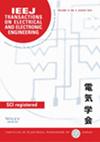求助PDF
{"title":"A Demand-Side Resource Selection Method for Feature Aggregation Based on Load Mapping","authors":"Bin Li, Tianyue Tang, Dan Wu, Shiming Tian, Yuting Xu, Shanshan Shi, Kaiyu Zhang","doi":"10.1002/tee.24149","DOIUrl":null,"url":null,"abstract":"<p>In order to improve the intuitiveness and automation of demand-side resource selection, a demand-side resource selection method based on load mapping matching is proposed in view of the increasing challenges of supply–demand balance in power networks and the rapid development of power demand-side management technologies. First, a two-dimensional load mapping of demand-side resources is drawn, and the load mapping is processed by Gaussian convolutional difference method. Then, feature points are extracted and located for the target resources and the loads of other resources in the demand-side resource pool, and similar feature key point pairs of demand-side resources are obtained. Finally, the demand-side resources with similar load characteristics to the target resources in the resource pool are screened according to the number of similar feature key point pairs, and the load resources similar to the target resources are finally identified by dividing the resource selection into priority levels. The experimental results show that the method can effectively extract feature key points, clearly and intuitively represent the features of demand-side resource load mapping, and can match to load resources with similar characteristics, which greatly transforms the demand-side resource selection mode. © 2024 Institute of Electrical Engineers of Japan and Wiley Periodicals LLC.</p>","PeriodicalId":13435,"journal":{"name":"IEEJ Transactions on Electrical and Electronic Engineering","volume":"19 11","pages":"1788-1802"},"PeriodicalIF":1.0000,"publicationDate":"2024-06-18","publicationTypes":"Journal Article","fieldsOfStudy":null,"isOpenAccess":false,"openAccessPdf":"","citationCount":"0","resultStr":null,"platform":"Semanticscholar","paperid":null,"PeriodicalName":"IEEJ Transactions on Electrical and Electronic Engineering","FirstCategoryId":"5","ListUrlMain":"https://onlinelibrary.wiley.com/doi/10.1002/tee.24149","RegionNum":4,"RegionCategory":"工程技术","ArticlePicture":[],"TitleCN":null,"AbstractTextCN":null,"PMCID":null,"EPubDate":"","PubModel":"","JCR":"Q4","JCRName":"ENGINEERING, ELECTRICAL & ELECTRONIC","Score":null,"Total":0}
引用次数: 0
引用
批量引用
Abstract
In order to improve the intuitiveness and automation of demand-side resource selection, a demand-side resource selection method based on load mapping matching is proposed in view of the increasing challenges of supply–demand balance in power networks and the rapid development of power demand-side management technologies. First, a two-dimensional load mapping of demand-side resources is drawn, and the load mapping is processed by Gaussian convolutional difference method. Then, feature points are extracted and located for the target resources and the loads of other resources in the demand-side resource pool, and similar feature key point pairs of demand-side resources are obtained. Finally, the demand-side resources with similar load characteristics to the target resources in the resource pool are screened according to the number of similar feature key point pairs, and the load resources similar to the target resources are finally identified by dividing the resource selection into priority levels. The experimental results show that the method can effectively extract feature key points, clearly and intuitively represent the features of demand-side resource load mapping, and can match to load resources with similar characteristics, which greatly transforms the demand-side resource selection mode. © 2024 Institute of Electrical Engineers of Japan and Wiley Periodicals LLC.
基于负载映射的特征聚合需求方资源选择方法
为了提高需求侧资源选择的直观性和自动化程度,针对电网供需平衡日益严峻的挑战和电力需求侧管理技术的快速发展,提出了一种基于负荷映射匹配的需求侧资源选择方法。首先,绘制需求侧资源的二维负荷映射图,并采用高斯卷积差分法对负荷映射图进行处理。然后,对目标资源和需求侧资源池中其他资源的负荷进行特征点提取和定位,得到需求侧资源的相似特征关键点对。最后,根据相似特征关键点对的数量筛选出资源池中与目标资源负载特征相似的需求侧资源,通过划分资源选择的优先级,最终确定与目标资源相似的负载资源。实验结果表明,该方法能有效提取特征关键点,清晰直观地表现需求侧资源负荷映射的特征,并能匹配到具有相似特征的负荷资源,极大地改变了需求侧资源选择模式。© 2024 日本电气工程师学会和 Wiley Periodicals LLC。
本文章由计算机程序翻译,如有差异,请以英文原文为准。

 求助内容:
求助内容: 应助结果提醒方式:
应助结果提醒方式:


